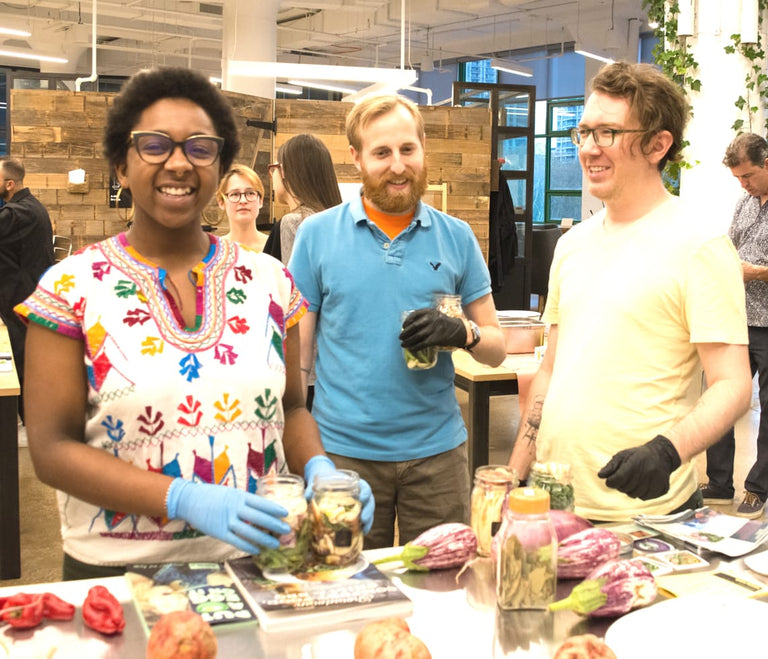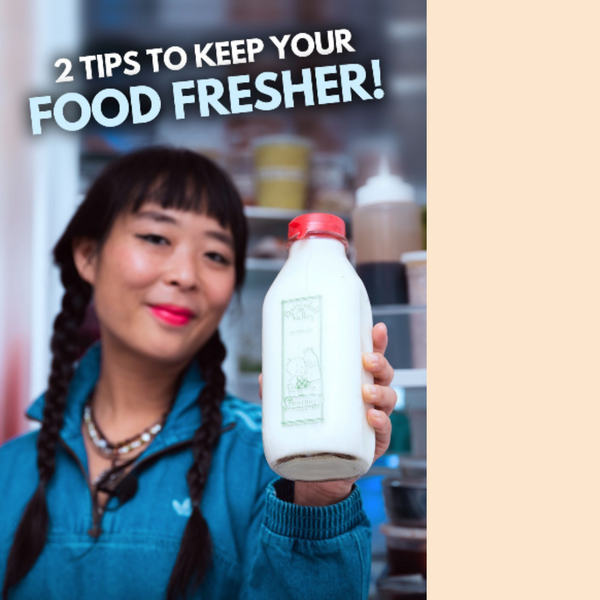How to Start Composting (in a Tiny NYC Apartment)
By Jessica Kulick, Local Roots subscriber + food loverListen, I was like you once. There was no way that I would have considered adding even the smallest new chore to my seemingly never-ending To Do list, especially after hustling day in and day out in the city that never sleeps.
So when a former roommate suggested we start composting, it was a hard “no” from me.
Luckily, she ignored me and did it anyway. And sure enough, I’m amongst the composting converted.
Now it’s my turn to pay it forward. Because here’s the truth: composting is not hard! Plus, it's hugely beneficial for both your neighborhood and the planet.
Here’s my quick and easy guide on how to start composting in your tiny NYC apartment, from the least amount of effort (for you newbies out there) to the most amount of effort (for you old hats looking to up your game). Let’s do it:
What is Compost, Anyway?

According to Grow NYC, food comprises a full 21% of New York City’s waste, which ultimately goes to landfill, leading to greenhouse gas emissions (bad for the planet) and significant disposal costs (bad for your wallet). When NYC citizens compost, that waste instead becomes a useful product that improves the quality of the soil for street trees, public parks and gardens, and more.
What can go into your compost pile? Food scraps, which are things like apple cores, potato peels, tea bags, nut shells, and non-greasy pastas, breads, and rice. Even soiled paper products like plates and napkins can go into your compost pile! And yard waste, which includes things like dried flowers, houseplants, leaves, and grass clippings.
I know we’ve all heard that horse manure makes great fertilizer, but do not put poop of any kind into your compost pile. 💩
Freezer Compost
Putting compost in your freezer is by far the simplest and easiest way to start composting. First, you’ll need to procure a container that you don’t mind getting dirty. This container can be a large Tupperware or small pail—it doesn’t matter, as long as you’re comfortable using it to hold cracked egg shells and old coffee grounds. I personally like using a large paper bag, like the grocery bags from Trader Joe’s and Whole Foods.
Once you’ve selected a container, start dropping in your daily food scraps and storing the Tupperware/paper bag in your freezer when not in use. When it’s full, take it to one of New York City’s 100+ drop-off points. This list shares the locations and hours for every single compost drop-off point across the city.
For my household (which is made up of two adults who cook a lot), dropping it off once a week is ideal. Then we just start fresh each week with a new paper bag.
Are you one of the lucky ducks who happens to live in a neighborhood with those mysterious brown bins? Fantastic! Make sure to line your brown bin with a clear plastic trash bag, then simply dump your compost in, and the Department of Sanitation will handle it curbside. Some kindly New Yorkers even place an "I Share My Bin" sticker on their brown bins, indicating that they're OK with you dumping your compost with theirs!
Hot Tips:
-
Be sure to rinse and dry your Tupperware/pail after it’s been emptied.
-
If you used a plastic bag, you’ll need to dump the contents of the bag and then throw away the bag itself—plastic is not compostable!
-
If you use a paper bag to hold your compost while in the freezer, simply throw the entire bag into the bin—my fave option. No muss, no fuss.
Countertop Compost
This is the exact same process as above, except with an airtight pail that gets stationed on your kitchen countertop or under the sink. Many compost pails are made of plastic, but you can also find them in stainless steel or even bamboo.
Word to the wise: this method is smellier (because it’s not frozen). You’ve been warned.
Worm Compost
You may be surprised to find out that worm composting, also known as vermiculture, is not a stinky endeavor! (And if it is, that’s a sure sign you need to readjust.) So while you won’t need a face mask, you’ll definitely want some proper gardening gloves, since you’ll need to handle some Eisenia foetida—a.k.a. Red Wigglers—to get started.
How many? The standard is two pounds of worms (that’s about 2,000 wigglers) per pound of food waste per day. To figure out how much food waste your household generates on average, monitor it for a week and divide by seven. It’s best to start with a little less than you need, because healthy worm populations will double every 90 days.
You’ll also need: a large opaque 15-gallon container with a top, a drill, shredded newspaper, some gritty material like sand, leaves, or crushed egg shells, and a safe spot in your home with a temperature range of 55-75° F.
If you’re not interested in going the DIY route, you can skip all that and just purchase a worm composting kit instead. We like the Worm Factory 360 (yes, it’s really called that) from Nature’s Footprint, which comes with everything you need to be successful.
Side note: starting your worm compost is a great activity to do with kids!
First, drill air holes around the top edge of the container so that oxygen can flow through. Then create their habitat by filling the bottom of the bin with damp newspaper strips until it’s about one-third full. While worms prefer an environment that is 75% water, it should be moist, not dripping. Then add in your gritty materials: that’s the sand or leaves or crushed egg shells.
Make your worms comfortable by digging down into the middle of the bedding and placing them there to start—don’t just drop them on top! Let them settle into their new home for about a week.
Once the initial week has passed, start feeding them food scraps like fruit and vegetable peels, coffee grounds, and egg shells.
Hot Tips:
-
Things you cannot feed to your worms: meat, bones, dairy, and citrus fruits.
-
You may try experimenting with grains and pasta, though—your worms will let you know whether they enjoy it or not.
-
If you find that they’re eating too slowly, chop the fruits and vegetables into smaller pieces. If they’re still overwhelmed, feed them less in quantity and/or frequency.
You’ll know it’s time to harvest your compost when the contents of the bin are mostly brown and earthy-looking. Grab those garden gloves, then lay out a large plastic sheet. Dump the bin’s entire contents onto the sheet, then manually separate the worms from the compost. Keep some of the compost to mix back in, along with some new bedding for your worm friends. Then the cycle starts all over again.
Use your compost for potted plants or for enriching bagged soil mixes.
Outdoor Compost
Does your space have a backyard? Then you can try outdoor composting! It’s really simple—even easier than worm composting—but I saved it for last because it takes the longest to turn into actual compost and, let’s be honest, you have an NYC real estate unicorn.
Choose a dry, shady spot near a water source. Add in your food scraps and yard waste: be sure to layer them, and to moisten dry materials as they’re added. Turn the pile regularly with a pitchfork; this will help speed up the composting process. The compost is ready when it has the consistency and color of healthy soil; this will take anywhere from two months to a year, depending upon what goes into your compost and how often you turn it.
Rather have a taste first?
Local Roots Experiences are fun, pop-up events where we bring the farm to you!

Become a Harvest Club Pick Up Location
Are you a NY based cafe, bar, or neighborhood business? Become a Harvest Club pick up location and have community members come to your establishment each week to pick up their Local Roots harvest.
Top







